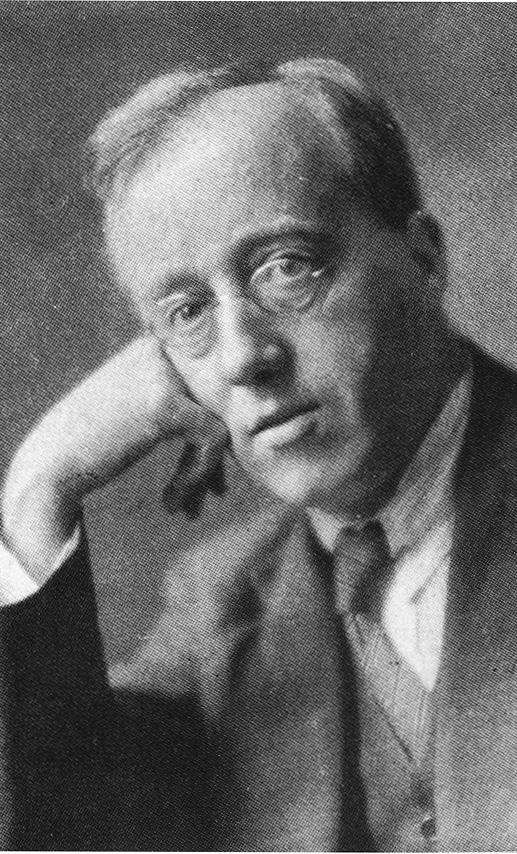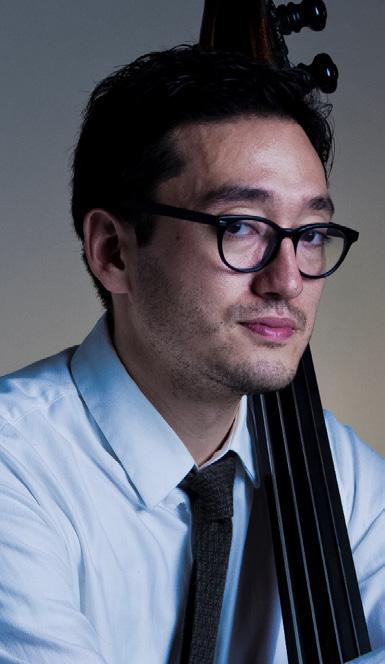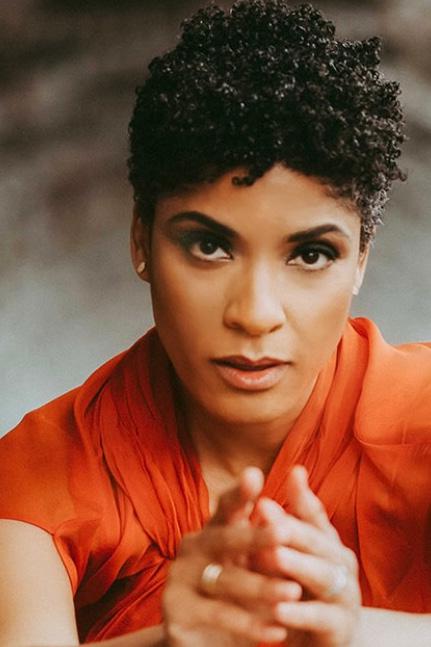Program notes by J. Mark Baker
MSO Artistic Partner Aaron Diehl returns to Milwaukee to premiere the complete full-orchestra version of jazz composer Mary Lou Williams’s Zodiac Suite. After intermission, we’ll stay among the stars for Holst’s The Planets.
MARY LOU WILLIAMS

Born 8 May 1910; Atlanta, Georgia
Died 28 May 1981; Durham, North Carolina
Zodiac Suite
Composed: 1942-45
First performance: 31 December 1945
Last MSO performance: MSO premiere
Instrumentation: flute (doubling piccolo); oboe; clarinet (doubling bass clarinet); tenor saxophone; bassoon; horn; trumpet; trombone; strings
Approximate duration: 30 minutes
Popularly known as “the first lady of jazz keyboard,” Mary Lou Williams (née Mary Alfrieda Winn) was one of the first significant female instrumentalists in jazz. A child prodigy, at age two, she was picking out simple tunes on the family piano, and at age three began piano lessons with her mother. A prolific composer, she was also a master arranger, creating musical scores for Duke Ellington, Benny Goodman, and other swing-era bands. Assuming the roles of friend, mentor, and teacher, her circle included such luminaries as Thelonious Monk, Charlie Parker, Miles Davis, Budd Powell, and Dizzy Gillespie.
Her pianism has been described as a distinctively understated, legato style based on subtly varied stride and boogie-woogie bass patterns. At the same time, she was a major advocate of postwar modern jazz, constantly probing harmonies and articulations in a manner that allowed her to retain a reputation as a “modernist” for most of her career. And she made it a point to study the music of Stravinsky and Schoenberg.
Some of her most important arrangements include “Froggy Bottom,” “Walkin’ and Struttin’,” “Mary’s Idea” (all for Andy Kirk’s band, 1936-38), and “Roll ’em” (for Benny Goodman, 1937). She also penned the bop piece “In the Land of Oo-bla-dee” and, following her conversion to Roman Catholicism, composed several sacred works, including a mass. Her cantata Black Christ of the Andes (1963) is a notably successful fusion of jazz and church music.
She briefly played in Duke Ellington’s band, writing for him the well-known “Trumpet No End.” It was about this same time that she penned her 12-movement Zodiac Suite, a winning fusion of jazz and classical idioms, inspired by musical associates of Williams who were born under the respective constellations.
62 MILWAUKEE SYMPHONY ORCHESTRA
• Aries: Billie Holiday, Ben Webster
• Taurus: Duke Ellington
• Gemini: Shorty Baker
• Cancer: Lem Davis
• Leo: Vic Dickenson
• Virgo: Phil Moore
• Libra: Art Tatum, Dizzy Gillespie, Bud Powell, Thelonious Monk, Charlie Parker, John Coltrane
• Scorpio: Ethel Waters, Katherine Dunham, Al Lucas
• Sagittarius: Eddie Heywood
• Capricorn: Pearl Primus, Frankie Newton
• Aquarius: Josh White, Eartha Kitt
• Pisces: Al Hall, Barney Josephson
The work exists in several versions: jazz trio, piano and chamber ensemble, and piano and symphony orchestra. In June 1945, Williams recorded the jazz trio version on the Asch record label. It has since been re-released on the Smithsonian label and can be found on YouTube. (It’s worth the time!)
At the end of that year, she presented a version for chamber orchestra at Town Hall in New York, conducted by Milton Orent, whom Williams credited with having a hand in the orchestration. The following summer came full symphonic orchestrations of three of the 12 movements, with the Carnegie Pops Orchestra. The arrangement heard on these MSO concerts was prepared by Jeffrey Sultanof and Rob Duboff, published in 2011 with the authorization of the Mary Lou Williams Foundation, Inc.
GUSTAV HOLST

Born 21 September 1874; Cheltenham, England
Died 25 May 1934; London, England
The Planets, Opus 32
Composed: 1914-16
Premiere: 28 September 1918; London, England
Last MSO performance: February 2017; Edo de Waart, conductor
Instrumentation: 4 flutes (3rd doubling piccolo, 4th doubling piccolo and alto flute); 3 oboes (3rd doubling bass oboe and English horn); 3 clarinets; bass clarinet; 3 bassoons; contrabassoon; 6 horns; 4 trumpets; 3 trombones; tuba; tenor tuba; 2 timpani; percussion (bass drum, cymbals, glockenspiel, gong, snare drum, tambourine, triangle, xylophone); 2 harps; celeste; organ; strings
Approximate duration: 51 minutes
These pieces were suggested by the astrological significance of the planets. There is no program music in them, neither have they any connection with the deities of classical mythology bearing the same names. If any guide to the music is required, the subtitle of each piece will be found sufficient, especially if it is used in a broad sense. For instance, Jupiter brings jollity in the ordinary sense, and also the more ceremonial kind of rejoicing associated with religious or national festivities. Saturn brings not only physical decay, but also a vision of fulfillment. Mercury is the symbol of mind.
– Gustav Holst
MILWAUKEE SYMPHONY ORCHESTRA 63
The English composer Gustav Holst is best known for his seven-movement suite The Planets That such should be the case was a source of great consternation to him – much like Boléro for Ravel or the piano prelude in C-sharp minor for Rachmaninoff. With other fine orchestral music, several operas, chamber music, songs, and a plethora of sublime choral music in his catalogue, the composer never thought it his best work; he was flummoxed by the sensation it caused. Regarding success, he stated, “It made me realize the truth of ‘Woe to you when all men speak well of you.’”
Born into a musical household – his father was a pianist and organist, his mother a pianist and singer – Gustavus Theodore von Holst’s family tree had its roots in Scandinavia, Russia, and Germany (he anglicized his name in the course of WWII). As a child, he took piano lessons and began writing music while still in grammar school. In his late teens, he entered the Royal Academy of Music, where he studied composition with the eminent Charles Villiers Stanford (1852-1924). At the RCM, he met fellow student Ralph Vaughan Williams (1872-1958). The two immediately became fast friends and began the lifelong habit of playing their newest works-inprogress to each other.
Throughout his adult life, Holst was a teacher – and an influential one. That profession took up most of his time, allowing him to compose only on weekends and in August, when he worked undisturbed in his soundproof music room at St. Paul’s Girls’ School, Hammersmith. Appointed director or music there in 1905, it was the only teaching post he kept to the end of his life. Often lecturing in evening institutes as well, he was forced to save up his compositional ideas until the end of each week. That’s why it took him two years (1914-16) to write The Planets. (Bad eyesight and neuritis in his right arm had kept him from war service.)
As Holst makes clear in the quote on the previous page, offered in connection with the work’s first performance, The Planets was conceived with an astrological, rather than astronomical, mindset. Holst was first introduced to astrology in 1913 by Clifford Bax, brother of composer Arnold Bax, while the two were on a tour of Spain. Not long afterward, he wrote to a friend, “Recently the character of each planet suggested lots to me, and I have been studying astrology fairly closely.” Thus, their contrasting personalities gave rise to a work unlike anything he had ever composed.
The first performance was for an invited audience of a few hundred people; Sir Adrian Boult led the New Queen’s Hall Orchestra. Many thought Mars was a depiction of the war still being fought, when in fact it was composed prior to August 1914. The end of Neptune – with its offstage women’s chorus fading into silent infinity – caused the biggest commotion, but Holst’s own favorite was always Saturn. Over one hundred years later, the piece never fails to please. His daughter and biographer Imogen Holst (1907-84) summed it up best: “During the many years since it was written, The Planets has suffered from being quoted in snippets as background music, but in spite of all unwanted associations it has survived as a masterpiece, owing to the strength of Holst’s invention.”
64 MILWAUKEE SYMPHONY ORCHESTRA
2022.23 SEASON
KEN-DAVID MASUR
Music Director
Polly and Bill Van Dyke
Music Director Chair
EDO DE WAART
Music Director Laureate
YANIV DINUR
Resident Conductor
CHERYL FRAZES HILL
Chorus Director
Margaret Hawkins Chorus Director Chair
TIMOTHY J. BENSON
Assistant Chorus Director
FIRST VIOLINS
Ilana Setapen, Acting Concertmaster, Charles and Marie Caestecker
Concertmaster Chair
Jeanyi Kim, Acting Associate Concertmaster (2nd Chair)
Alexanders Ayers, Acting Assistant Concertmaster
Yuka Kadota
Ji-Yeon Lee**
Dylana Leung
Allison Lovera
Lijia Phang
Margot Schwartz*
Alejandra Switala**
Yuanhui Fiona Zheng
SECOND VIOLINS
Jennifer Startt, Principal, Andrea and Woodrow Leung Second Violin Chair
Timothy Klabunde, Assistant Principal
John Bian, Assistant Principal (3rd Chair)
Glenn Asch
Lisa Johnson Fuller
Paul Hauer
Hyewon Kim
Shengnan Li*
Laurie Shawger
Mary Terranova
VIOLAS
Robert Levine, Principal, Richard O. and Judith A. Wagner Family Principal Viola Chair
Samantha Rodriguez, Acting Assistant Principal, Friends of Janet F. Ruggeri
Viola Chair
Alejandro Duque, Acting Assistant Principal (3rd Chair)
Elizabeth Breslin
Nathan Hackett
Erin H. Pipal
Helen Reich
CELLOS
Susan Babini, Principal, Dorothea C. Mayer Cello Chair
Nicholas Mariscal, Assistant Principal
Scott Tisdel, Associate Principal Emeritus
Madeleine Kabat
Peter Szczepanek
Peter J. Thomas
Adrien Zitoun
BASSES
Jon McCullough-Benner, Principal, Donald B. Abert Bass Chair
Andrew Raciti, Associate Principal
Nash Tomey, Assistant Principal (3rd Chair)
Brittany Conrad
Peter Hatch
Paris Myers
HARP
Julia Coronelli, Principal, Walter Schroeder Harp Chair
FLUTES
Sonora Slocum, Principal, Margaret and Roy Butter Flute Chair
Heather Zinninger, Assistant Principal
Jennifer Bouton Schaub
PICCOLO
Jennifer Bouton Schaub
OBOES
Katherine Young Steele, Principal, Milwaukee Symphony League Oboe Chair
Kevin Pearl, Assistant Principal
Margaret Butler
ENGLISH HORN
Margaret Butler, Philip and Beatrice Blank English Horn Chair in memoriam to John Martin
CLARINETS
Todd Levy, Principal, Franklyn Esenberg Clarinet Chair
Benjamin Adler, Assistant Principal, Donald and Ruth P. Taylor Assistant Principal Clarinet Chair
Taylor Eiffert
E FLAT CLARINET
Benjamin Adler
BASS CLARINET
Taylor Eiffert
BASSOONS
Catherine Van Handel, Principal, Muriel C. and John D. Silbar Family Bassoon Chair
Rudi Heinrich, Assistant Principal
Beth W. Giacobassi
CONTRABASSOON
Beth W. Giacobassi
HORNS
Matthew Annin, Principal, Krause Family French Horn Chair
Krystof Pipal, Associate Principal
Dietrich Hemann, Andy Nunemaker French Horn Chair
Darcy Hamlin
Kelsey Williams**
TRUMPETS
Matthew Ernst, Principal, Walter L. Robb Family Trumpet Chair
David Cohen, Associate Principal, Martin J. Krebs Associate Principal
Trumpet Chair
Alan Campbell, Fred Fuller
Trumpet Chair
TROMBONES
Megumi Kanda, Principal, Marjorie Tiefenthaler
Trombone Chair
Kirk Ferguson, Assistant Principal
BASS TROMBONE
John Thevenet, Richard M. Kimball Bass Trombone Chair
TUBA
Robyn Black, Principal
TIMPANI
Dean Borghesani, Principal
Chris Riggs, Assistant Principal
PERCUSSION
Robert Klieger, Principal
Chris Riggs
PIANO
Melitta S. Pick Endowed Piano Chair
PERSONNEL MANAGERS
Françoise Moquin, Director of Orchestra Personnel
Constance Aguocha, Assistant Personnel Manager
LIBRARIAN
Paul Beck, Principal Librarian, Anonymous Donor, Principal Librarian Chair
PRODUCTION
Tristan Wallace, Technical Manager & Live Audio Supervisor
Paolo Scarabel, Stage Technician & Deck Supervisor
* Leave of Absence 2022.23 Season
** Acting member of the Milwaukee Symphony Orchestra 2022.23 Season
MILWAUKEE SYMPHONY ORCHESTRA 65







